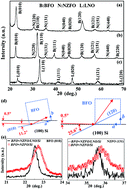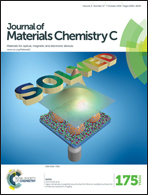RF magnetron co-sputtering growth and characterisation of multiferroic composite films of Ni0.5Zn0.5Fe2O4 + BiFeO3
Abstract
Multiferroic composite films of Ni0.5Zn0.5Fe2O4 (NZFO) + BiFeO3 (BFO) were deposited on the Si and LaNiO3 (LNO) buffered Si substrates at 700 °C, by co-sputtering from two individual targets of the components. The films grown on LNO/Si had a microstructure characterised by fine NZFO grains (∼25 nm) embedded in large BFO grains (>100 nm), i.e. a typical 0–3 connectivity. A grain–epitaxy relation was observed between BFO and LNO, which were deposited on Si as the bottom electrode. There were residual strains in both BFO and NZFO grains. The former was confirmed by the shift of the d-spacing in X-ray diffraction patterns, while the latter was supported by a uniaxial distortion of the cubic magnetocrystalline anisotropy as revealed by the fitting of the temperature-dependent coercivity. The NZFO + BFO composite films exhibited a clear exchange bias, which was about 37 Oe at 2 K and dropped to 11 Oe at room temperature. The absence of interfacial reaction, as evident by the occurrence of exchange bias, and yet the presence of residual strains from the growth process led to very large magnetoelectric coefficients either with or without a static bias magnetic field. The maximum value reached 869 mV cm−1 Oe−1 at a resonance frequency of 10 kHz and a bias field of 6.5 kOe.



 Please wait while we load your content...
Please wait while we load your content...